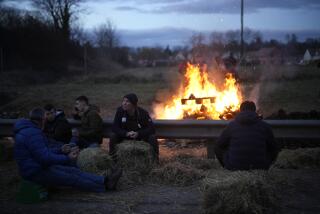Mad-Cow Worries Have French Counting Sheep
- Share via
SISTERON, France — As the French snub beef, this should be the year of the lamb. A juicy pink gigot d’agneau is, after all, the national dish. But good lamb is virtually handmade, and dedicated sheep people are a diminishing breed.
“Sure, people want more, and we need the money,” said Francoise Garcin, in a barn full of fluffy lambs she is fattening for the kill. “But this is no industrial product. We can sell only what nature provides.”
With Europe in panic over mad cow disease, poultry sales have nearly doubled. Pork people report a windfall. The French eat 15% more horse meat. Ostrich fillet sells briskly at $12 a pound.
But the 5 million sheep that produce meat proceed at their same old pace here in the Provence Alps and elsewhere, following shepherds to high pastures in summer and huddling in heated sheds over the winter.
“Talk about a 24-7 occupation,” Garcin said. “These are living creatures, and their needs never let up. We can make a living, but it is very, very hard work. Not many kids want to do it.”
Each year, 3,000 to 5,000 families quit the business, and only 50,000 are left, said Bernard Bouffartigues of the National Sheep-Raisers’ Federation. A school to train sheepherders turns out only 15 graduates a year.
Garcin raises 350 lambs a year, feeding them grain for 100 days until they head off to be Christmas dinner, Easter lunch or a summer barbecue. In spring, she and her husband walk eight hours to take their 700 sheep to clover.
“We do it the old way because we like it,” she said. “Mostly, farmers use trucks. People love to see us go by. It takes them back to another time. Our son is 18, and he has the passion. But few of his friends do.”
Before the beef scare late last year, angry shepherds were driving flocks onto Paris streets to demand higher subsidies against competition from big farms.
By Christmas, a sudden new demand for lamb raised prices by 25%, sparking hopes that the business would revive.
But the beef crisis was a mixed blessing.
First, European officials committed huge sums to combating mad cow disease with mass testing and slaughters, leaving little money for lamb subsidies.
Then, in February, French scientists recommended that sheep also be tested for a related malady. It was only a precaution, they said, but the warning was enough to swell the ranks of vegetarians.
“It is clear that without more help in the long term, shepherds and the old ways of producing good lamb are on their way out,” Bouffartigues said.
“There is a crisis,” agreed Roland Isnard, head of the Sisteron producers’ cooperative, “but here, at least so far, we’re confident. People know the care we take. Every kilo we sell can be traced directly to the source.”
In France these days, the buzzword “traceability” dominates every sector of the food business. It was the leitmotif of the 38th Paris Agriculture Salon, opened Feb. 18 by President Jacques Chirac.
Even in discount supermarkets, meat counters name the producer and the feed. Customers eye them carefully with mixed effect.
Beef has been hit hardest, with sales briefly falling 80% before leveling out around 20% down.
Sheep people, meanwhile, push their limits and hope for the best.
“In the end, our quality will save us,” said Jacques Pellier, who directs the spanking clean, high-tech Sisteron Municipal Abattoir, France’s largest sheep slaughterhouse, which handles 550,000 animals a year.
Three years ago, when researchers began looking for an ovine form of the brain-destroying disease that affects cattle, the abattoir installed a system to extract all spinal marrow.
“You’ll only die of happiness over this stuff,” promised Robert Dantcikian, a butcher in the Provence city of Draguignan, as he slipped garlic cloves into a leg of Sisteron lamb and sprinkled it with herbs.
“The sheep eat only mountain grass and wildflowers, and the lambs feed on their milk,” he explained. “Meat doesn’t get any better.”
Claude Paix, a rival at the Draguignan market, agreed. He added, however, that buyers must beware. Questionable practices in the lamb and mutton trade could taint even the reliable producers.
Real Sisteron lamb comes with a distinctive tag and a bar code label that specifies who raised it and who brought it to slaughter.
“Sometimes lamb is raised in other places, Eastern Europe for instance, and only slaughtered in Sisteron,” Paix said. “If you don’t look at the label, you won’t know. If it’s cheap, that’s a clue.”
Butchers now sell leg of Sisteron lamb for about $6 a pound, 10% more than before the mad cow crisis. As gigot d’agneau, it is roasted as France’s favorite Sunday lunch or celebratory dish. Lamb chops cost $8 a pound, the same as top-quality standing beef rib.
More to Read
Sign up for Essential California
The most important California stories and recommendations in your inbox every morning.
You may occasionally receive promotional content from the Los Angeles Times.













